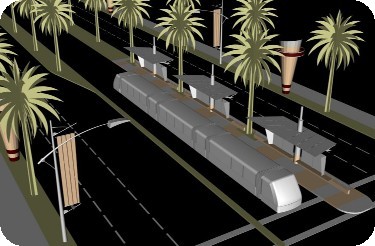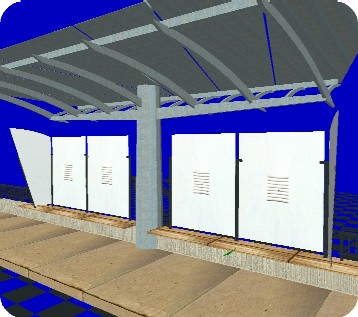Project Description | Progress Report | Updates | Updates 2 | Final Report | Code Repository

Participants: Jon Marbach, Jing Fang
Problem Statement: It should be should be first said that this project is a far reaching one and the goals span more than just a semesters work. The project will be described including the long term goals, and then some realistic goals may be outlined at the end.
The Virtual Bus Stop is to be a prototype and simulation environment for an "intelligent" bus stop which will make using public transportation easier for everyone - especially for those with cognitive disabilities. The intention is that this will be an immersive 3D environment that may be used to explore the problem domain by allowing potential users to get a feel for how such a bus stop might work and capturing feedback from them. Simulations may be run to illustrate shortcomings of current systems, showing the necessity of more advanced public transportation.
One potential part of the Virtual Bus Stop would be to allow users to make small configuation changes to the bus stop such as placement and number of touch screens, proximity to road, or existence of other computing devices and displays. The rationale for these changes could be documented, creating a catalog of design decisions.
Through the use of a motion tracked glove, the user could potentially interact with the display elements in the bus stop, possibly planning a route and being informed of a bus arrival time. Another possibility is to simulate the use of a handheld computing device to communicate with the busses and the bus stop itself. A small piece of this vision is a PDA could help identify the correct bus for a rider to board when three identical looking busses arrive at the stop.
This project is a piece of the L3D group's Mobility for All project.
Rationale:
Immersive 3D Visualization technologies have incredible potential benefit in many fields but up to this point, due to the high costs involved, have only been utilized in the Defense and Oil industries. We are very fortunate to have on campus an immersive visualization facility, the BP Center for Visualization, whose mission is in part to help expand visualization into other domains. This project is to be realized in the center's "CAVE" environment which is a 12'w x 12'd x 10'h cube (3 sides and a floor) onto which a 3D scene can be projected.
This project will be one of the first student research projects at the Visualization Center and can serve as a foundation of the new center's relationship with the campus. The hope is that this project will lay the groundwork in terms of software and operations for future projects at the center.
The importance of exploring the possiblities of an immersive 3D environment is that it may lead to new ways of designing, learning, and collaboration. The Virtual Bus Stop can potentially support design by allowing user modification, learning by capturing user feedback as they explore the environment, and collaboration by keeping a catalog of design changes that document differing rationales. A distinct advantage of a virtual prototype over a physical one is that the computational elemnts of the busstop can be simulated as well as the physical ones, which are the only elemts represented in a physical prototype.

Technical Approach and Implementation Plan
This is an area where the complicated nature of a visualization application and the newness of the Visualization Center's environment introduce serious risks in the application's development. The Center is in the process of acquiring software that will aid in the rapid development of visualization applications, but the timetable of this aquisition is uncertain. Therefore, at the moment, the plan is to develop the project with lower-level, hand-built, proprietary software while still maintaining the ability to migrate to another development environment mid project. The 3D models and scenes built will be stored in the VRML 2.0 format, a recognized and widely supported standard.
Another risk is that the center has limited time resources available. The progress of the project may be hindered if there are only three hours available per week for work. As a result, our team must try to work and independently from the center as possible so that only work that is critically performed in the CAVE will be done there.
The reasonable goals for the remainder of the semester are to get a bus stop up and navigable using the head tracking system and "wand" input device available at the visualization center. We expect to be able to implement some simple scripting capabilities to produce some simulations within the scene - for example: a sign says bus 205 will arrive in 30 seconds, a bus arrives, the sign says bus 205 heading for destination x, the bus departs. It should be noted that a large part of the effort in 3D simulation is the building of the models themselves. Related to that is the percieved quality of the system: the better looking the models and textures, the higher the percieved quality of the system. It should be understood that the team members are not artists, trained in the building of such models.
Although the semester goals are short of the total scope of the project, the intention is that this project may be continued beyond the extent of this course.
Refernces and Resources:
BP Center for Visualization
Mobility for All
Center for Lifelong Learning and Design
Note: The image above is not of the virtual bus stop but a rendering of a model from which a piece of the bus stop is being built. ...but palm trees in Boulder would be nice!
Semester Design Project Home Pages


